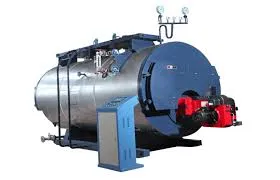
Nov . 26, 2024 22:16 Back to list
Understanding the Functionality of Thermal Oil Boilers in Industrial Applications
The Working Principle of Thermal Oil Boilers
Thermal oil boilers, also known as thermal fluid heaters or heat transfer fluid (HTF) boilers, are widely used in various industrial applications due to their efficiency in heat transfer and temperature regulation. Unlike conventional steam or water heating systems, they use a thermally stable oil as the heat transfer medium. This article will explore the working principle of thermal oil boilers, their components, and their numerous applications.
Fundamentals of Thermal Oil Heating
The primary purpose of a thermal oil boiler is to produce heat for industrial processes such as chemical processing, food production, and plastics manufacturing. The key advantage of thermal oil systems lies in their ability to operate at high temperatures without the risks associated with steam pressure systems. Thermal oils can maintain stable temperatures up to 300°C (or even higher in specialized systems), allowing for precise temperature control.
Components of a Thermal Oil Boiler
Thermal oil boilers consist of several main components
1. Burner The burner is responsible for generating heat by burning fuel. It can operate on various fuels, including natural gas, fuel oil, or biomass.
2. Heat Exchanger The heat exchanger is where the combustion gases transfer heat to the thermal oil. This component ensures efficient heat transfer while maintaining a separation between the combustion process and the oil.
3. Thermal Oil Circulation System This system comprises pumps, piping, and valves that circulate the thermal oil throughout the system. The thermal oil absorbs heat from the heat exchanger and carries it to the required processes or equipment.
4. Control System An automated control system is essential for monitoring temperature, pressure, and flow within the system. This system helps maintain optimal operating conditions and enhances safety by preventing overheating or excessive pressure build-up.
5. Expansion Tank As the thermal oil heats up, it expands. The expansion tank accommodates this expansion, ensuring that the system maintains a consistent pressure and protects against leaks or ruptures.
Operating Principle
The operation of a thermal oil boiler can be broken down into several stages
1. Fuel Combustion The process begins with the burner igniting the chosen fuel. The combustion generates hot gases that circulate through the heat exchanger.
2. Heat Transfer The hot combustion gases pass through the heat exchanger, where they transfer their heat to the thermal oil. The design of the heat exchanger ensures maximum surface area contact between the gases and the oil, promoting efficient heat transfer.
3. Thermal Oil Circulation Once heated, the thermal oil is pumped out of the boiler and directed to the specific application or process requiring heat. The oil can maintain a consistent flow rate, ensuring that processes receive a steady supply of heat.
thermal oil boiler working principle

4. Heat Usage The heated thermal oil is utilized in various applications, such as heating reactors, dryers, or other equipment. It can also be integrated into heat exchangers to transfer heat to secondary processes.
5. Cooling and Recirculation After the oil has transferred its heat, it returns to the boiler to be reheated once again, thus completing the cycle.
Advantages of Thermal Oil Boilers
Thermal oil boilers offer several advantages over traditional steam boilers
- Higher Efficiency They operate at higher thermal efficiency, reducing energy consumption and operational costs.
- Improved Safety With no high-pressure steam involved, thermal oil systems reduce the risk of explosions or scalding.
- Flexible Operating Temperatures They can easily adjust to different temperature requirements, making them suitable for a wide range of industries.
- Lower Maintenance Thermal oil systems typically require less maintenance compared to pressure-bound systems, as they do not involve elaborate safety measures associated with high-pressure steam systems.
Applications of Thermal Oil Boilers
Thermal oil boilers find application in numerous sectors, including
- Chemical Processing For heating reactors, distillation columns, and other processes.
- Food Industry Employed in drying and cooking processes.
- Plastics and Rubber Manufacturing Providing the necessary heat for molding and curing processes.
- Textile Industry Used in dyeing and drying operations.
Conclusion
Thermal oil boilers represent a highly efficient and safe method for industrial heat transfer. Understanding their working principles and advantages allows industries to select suitable heating solutions tailored to their specific needs. As energy efficiency and safety remain paramount in industrial operations, the popularity of thermal oil boilers continues to grow.
-
High-Efficiency Commercial Oil Fired Steam Boiler for Industry
NewsJul.30,2025
-
High-Efficiency Biomass Fired Thermal Oil Boiler Solutions
NewsJul.30,2025
-
High Efficiency Gas Fired Thermal Oil Boiler for Industrial Heating
NewsJul.29,2025
-
High-Efficiency Gas Fired Hot Water Boiler for Sale – Reliable & Affordable
NewsJul.29,2025
-
High Efficiency Biomass Fired Hot Water Boiler for Industrial and Commercial Use
NewsJul.29,2025
-
High-Efficiency Biomass Fired Hot Water Boiler for Industrial Use
NewsJul.28,2025
Related PRODUCTS






















